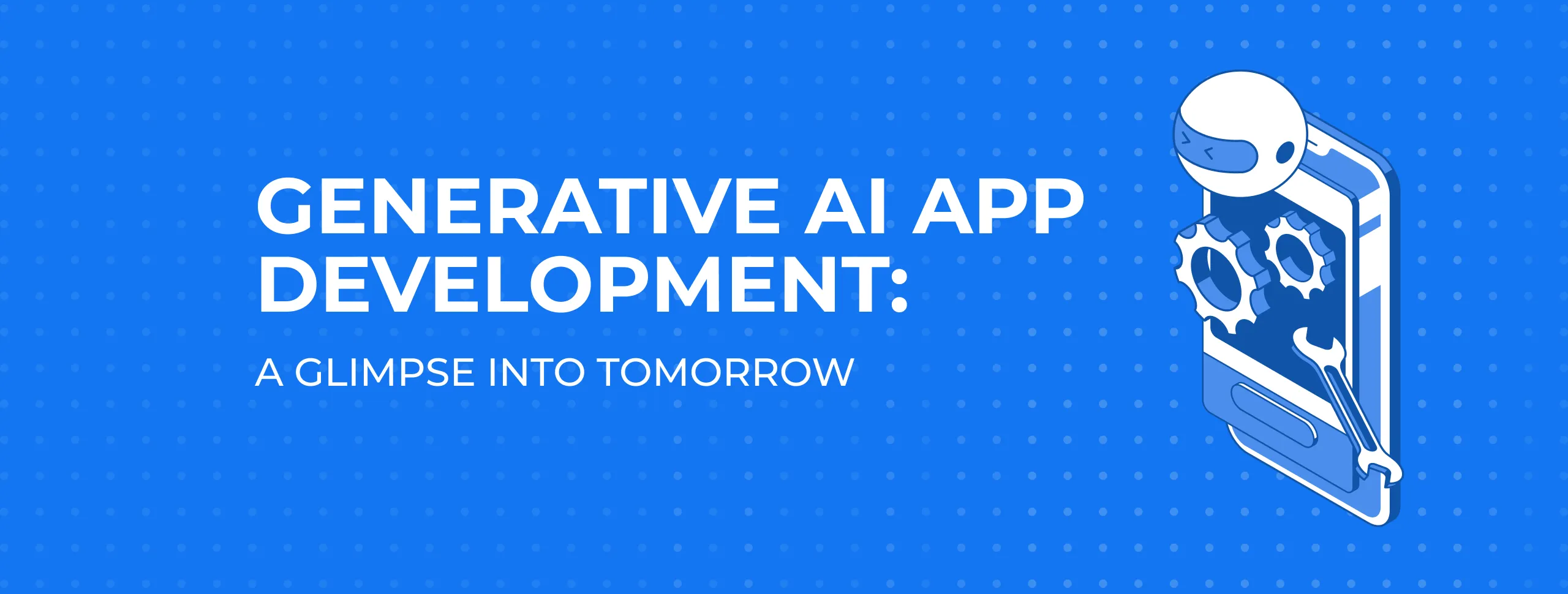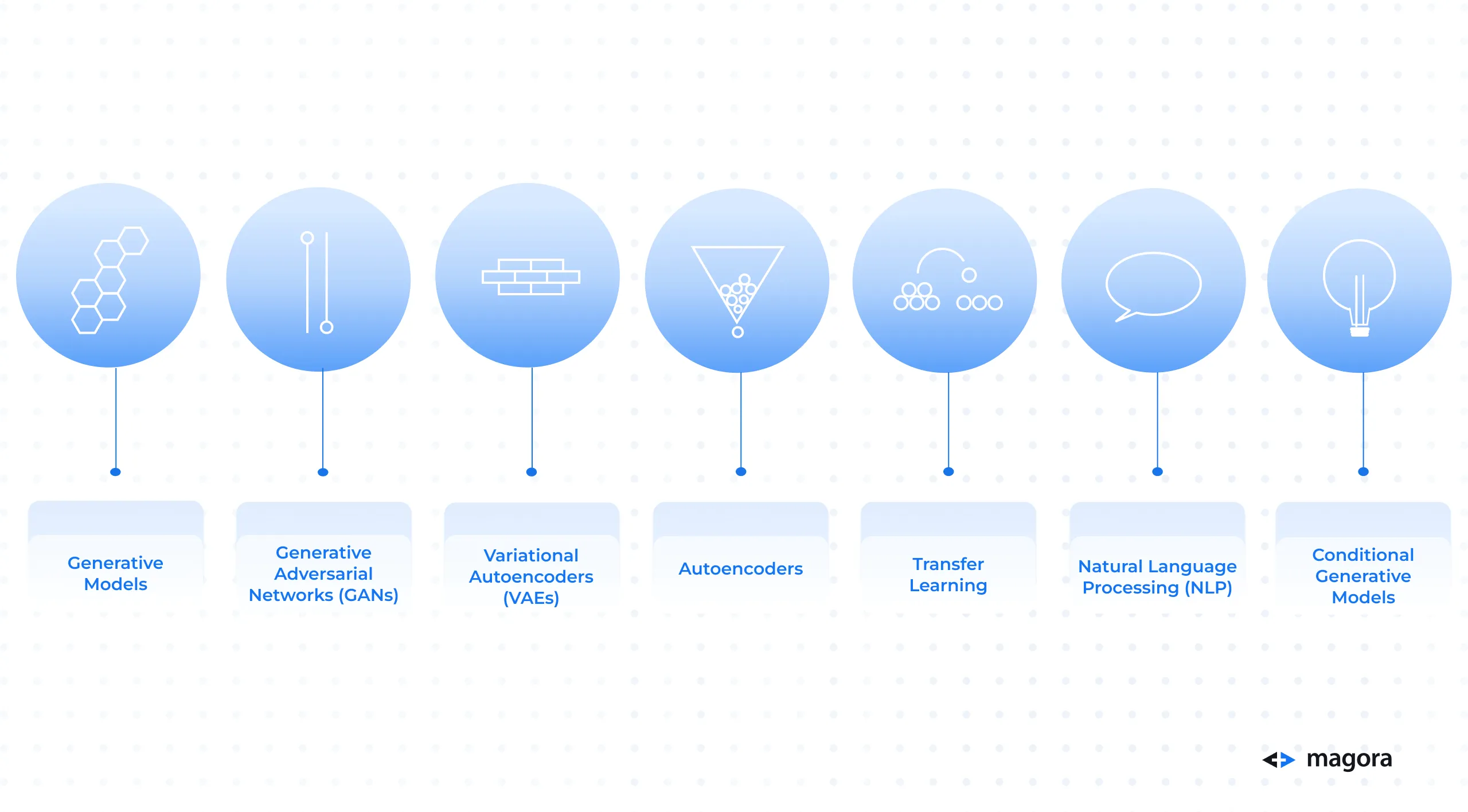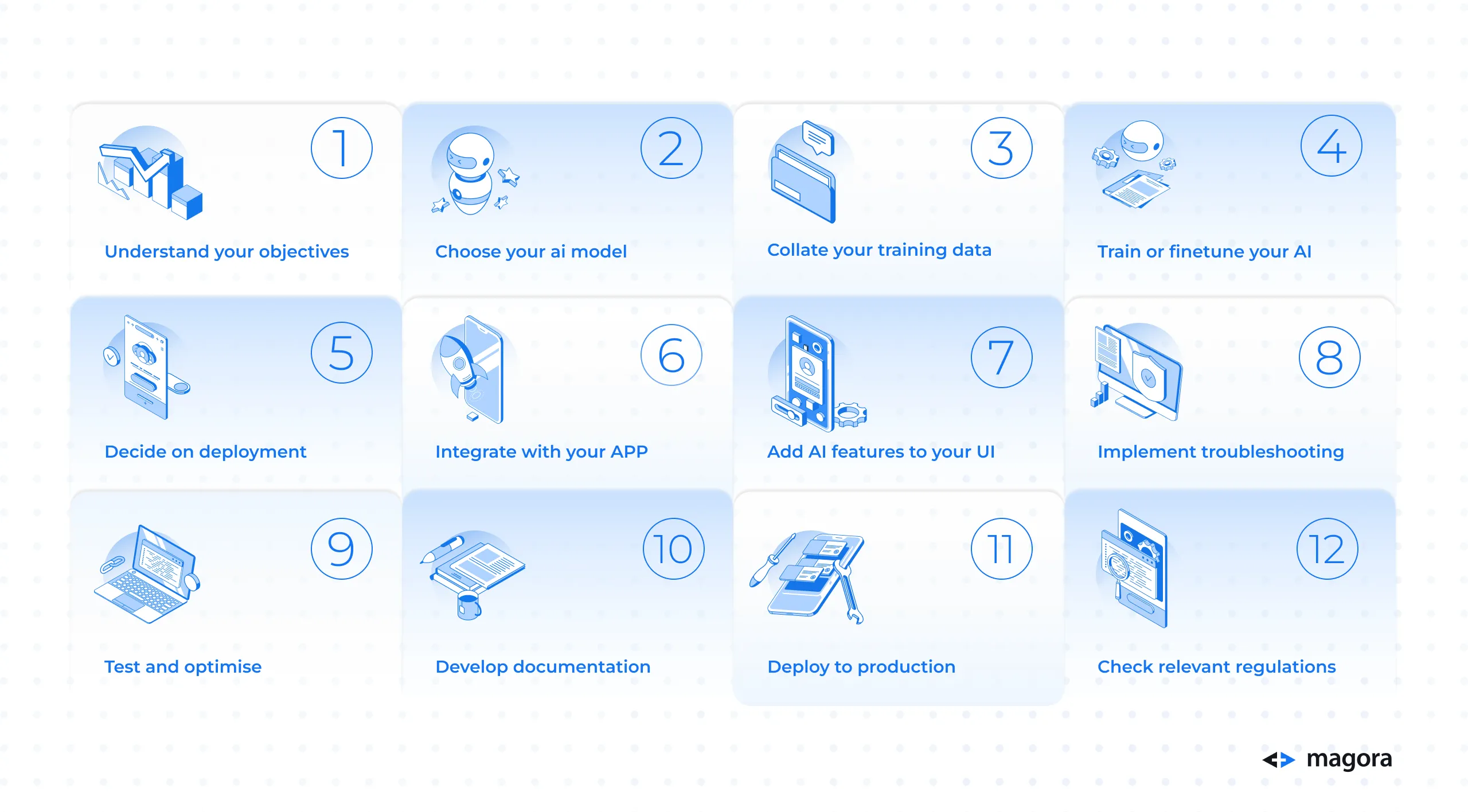
Generative AI App Development: a Glimpse Into Tomorrow

Table of contents
- What is Generative AI?
- Generative AI Concepts
- Examples of Generative AI Applications
- Generative AI App Development
- Legacy App Modernisation
- Generative AI Application Success Stories
- Future Trends in Generative AI App Development
- Generative AI Challenges and Considerations
- Conclusion
In the ever-evolving realm of technology, artificial intelligence (AI) continues to push the boundaries of innovation. Generative AI, a subset of AI, stands at the forefront of this transformation, empowering developers to create ground-breaking applications that were once unimaginable.
Harnessing the power of machine learning to generate entirely new content, ranging from images and music to text and code, generative AI is revolutionising the way we interact with computers, opening up a world of possibilities for personalised experiences, creative expression, and enhanced productivity.
At the heart of generative AI lie sophisticated algorithms trained on massive datasets of information. These algorithms analyse patterns and relationships within the data, enabling them to produce original content that mimics or extends existing human-created works. Encompassing a diverse range of techniques, each with its unique capabilities, from generative adversarial networks (GANs) that pit two neural networks against each other to produce realistic images and videos, to variational autoencoders (VAEs) that learn latent representations of data to generate new variations, these techniques are unlocking the potential of AI in unprecedented ways.
The impact of generative AI is already being felt across various industries, with app development at the forefront of this revolution. Developers are embracing the power of generative AI to create apps that are not only more engaging and personalised but also more efficient and productive.
As the technology continues to evolve, its impact on app development is destined to grow even more profound. We can envision a future where AI-powered tools become ubiquitous in the app development landscape, enabling developers to create apps that are not only smarter and more personalised but also capable of adapting and learning in real-time – we can expect to see a future where apps become seamlessly integrated into our lives, anticipating our needs, and enhancing our experiences in ways we never before imagined.
In this article we will look at the benefits and integrations of generative AI in app development, future trends in this field, success stories, challenges, and ethical considerations.
We will start with an introduction.
What is Generative AI?
The term Generative AI (GenAI) is used to describe any artificial intelligence (AI) system, or application (app), that creates new content, such as music, text, or images. You may have heard of OpenAI’s ChatGPT? Well, it’s one of the better-known examples of a generative AI model – primarily designed for natural language generation and conversation – that can be integrated into applications.
In its own words:
These systems use machine learning techniques, often based on neural networks, to learn patterns and structures in the data and then generate new, similar data.
Generative AI has applications in various fields, including image synthesis, text generation, art creation, and more. For example, it can be used to generate realistic images of objects or scenes that do not exist, to create natural-sounding text, or to compose music.
Not only a powerful technological innovation that could boost the economy tremendously – Goldman Sachs predicts that it “could raise global GDP by 7%” – but when it comes to app development, generative AI software optimises the process and end product phenomenally.
Unmatched in its ability to test for vulnerabilities quickly and efficiently, these systems can generate code, automate repetitive tasks, augment data for machine learning and problem solve without the need for much human assistance, which can lead to a better UX, UI and a bug-free app, not to mention less time and money spent on specialists. How effective it is depends on the quality of the training data and the specific use case.
Generative AI Concepts

Generative AI encompasses a set of techniques and concepts that sit under the AI umbrella. Primarily concerned with creating original content, as opposed to general AI which concentrates on recognising patterns and making decisions based on existing data, generative AI’s ability to produce new material, such as sounds, text, images, or code, sets it apart.
Neural networks play a pivotal role in app development by enabling advanced features such as natural language processing, image recognition, and predictive analytics for personalised user experiences.
Within generative AI, there are several types of methodologies:
Generative Models
Generative models are designed to produce fresh data resembling what they've been trained on. These machine learning models create authentic new samples by understanding the underlying patterns in the data they were given during training.
Generative Adversarial Networks (GANs)
GANs are a class of machine learning models that consist of two neural networks, a generator, and a discriminator, which are in competition to improve the generation of synthetic data. The generator generates synthetic data from random inputs – images, text, sounds – to deceive the discriminator, which simultaneously distinguishes what is real and what is fake.
Since the two networks are in competition, the process naturally improves as the game progresses, i.e. the latter becomes better at distinguishing the real from the fake.
Variational Autoencoders (VAEs)
VAEs work in an entirely different way to GANs. Comprised of autoencoder and probabilistic graphical model elements, they learn by encoding data into a lower-dimensional space and then decoding it to reconstruct the original data, enabling the generation of new samples.
Autoencoders
These neural networks comprise an encoder that transforms input data into a condensed representation, known as an encoding, while a decoder reconstructs the data from the compressed form. Autoencoders are particularly useful when intricate feature extraction and representation learning are required.
Transfer Learning
This machine learning framework leverages knowledge sourced from solving one task and applies it to a different, yet related task. This type of generative AI allows a pre-trained model to be fine-tuned and adapted to suit the new task at hand, transferring already learned patterns and features to enhance performance on said new task.
Natural Language Processing (NLP) in Generative AI
These models can understand and produce human-esque language and generate contextually relevant text.
Conditional Generative Models
Exhibiting an advanced capacity to take in additional information or conditions, conditional generative models have a heightened level of control and customisation in the outputs produced. They are able to tailor their generated content to align with specified criteria, giving a more personalised outcome when compared with traditional generative models.
Ok, give me some examples…
From chatbots and scriptwriting to drug discovery and financial forecasting, generative AI applications can do an awful lot – you may have already interacted with some of them. They are diverse in their application and are progressing at an incredible rate.
Increasingly popular with creators is image generation with AI – a good example being Adobe’s recently introduced Firefly capable of generating images from text, or Open AI’s Dall-e-3, which allows you ‘to easily translate your ideas into exceptionally accurate images’ – while Natural Language Processing (NLP) Apps are present in most of our day-to-day lives, from Google Translate to chatbots.
Deep Learning Applications meanwhile have optimised the multi-faceted medical industry in a number of ways, including diagnosis and detection. Code Generation with generative AI has also proven to be a huge hit utilised through apps such as GitHub Copilot and Amazon CodeWhisperer, while machine learning in app development used by platforms like Netflix and Spotify has led to personalised content suggestions being expected when we consume media.
We could fill another article listing the breadth of apps on the market today, but for the purposes of this piece, we will mention four of the big ones that you might not come across in your day-to-day life.
Developed by DeepMind, AlphaGo is skilled at playing the complex traditional board game Go. It became so good at the game that it defeated a world champion ‘a decade before experts thought possible’ proving ‘that AI systems can learn how to solve the most challenging problems in highly complex domains.’
Over on the creative side, we have Nvidia’s StyleGAN, a face synthesis app that creates wonderfully realistic images of people who don’t exist. While generative AI app MuseNet (OpenAI) produces music, and RunwayML enables the user to ‘generate videos with text prompts.’
The possibilities of generative AI software are breathtaking, and the benefits of generative AI in app development are vast.
Generative AI App Development

Enhanced creativity and innovation, personalisation and user engagement, and streamlined development processes are some of the core benefits of implementing generative AI in app development.
Having looked at what’s possible and what has already been achieved, let’s now look at how to develop an AI app.
1. Have a clear understanding of your objectives: how, specifically, do you want generative AI to enhance your app.
2. Choose your generative AI model.
3. Collect and prepare the data you’ll need to train your AI.
4. Train or fine-tune your AI.
5. Decide on your deployment approach.
6. Integrate with your app backend.
7. Reflect your new AI features in your UI.
8. Establish mechanisms to counter potential errors or feedback.
9. Test (comprehensively) and optimise.
10. Develop related documentation, including user manuals and maintenance requirements.
11. Deploy your app to production and set up a feedback loop to monitor its performance.
Finally, check that you are complying with all relevant regulations and have security measures in place to mitigate against potential future issues. And remember, it’s vital that you consider your generative AI framework before you start to build an app with AI.
Now, what if you already have an app that you’re happy with, but it’s no longer competing so well with its modern-day peers?
Modernising Your App
AI for application development is not only hugely advantageous when it comes to building new products, but generative AI is an incredible tool for legacy app modernisation too, i.e. ‘the process of updating legacy applications leveraging modern technologies, enhancing performance and making it adaptable to evolving business speeds by infusing cloud native principles like DevOps, Infrastructure-as-code (IAC) and so on’.
In fact IBM Technology states that ‘generative AI is revolutionising what is possible in the field of application modernisation’ with ‘83% of executives [saying that] modernising application and data is central to their organisation’s business strategy’ showing what a ‘hot topic’ legacy app modernisation is today.
The process starts with an ‘assessment of current legacy applications, data and infrastructure’ before ‘applying the right modernisation strategy (rehost, re-platform, refactor or rebuild) to achieve the desired result’.
To learn more about legacy app modernisation or discover how you can use artificial intelligence tools to optimise your product, head here.
Real World Applications (and Success Stories)
Generative AI is being used in a variety of ways to develop new and innovative apps.
Replika, a chatbot created by Luka can hold a conversation about a range of topics, while Artbreeder’s app enables the creation of AI-generated art. Similarly, AIVA will let you develop your own AI-generated music and Imagen can produce synthetic data to train computer vision models.
Let’s cast our eye to some of the real-life cases where generative AI’s app development capabilities have far exceeded what the brand owner thought possible.
First let’s look at IBM’s watsonx.ai – ‘train, validate, tune and deploy generative AI, foundation models and machine learning capabilities with ease and build AI applications in a fraction of the time with a fraction of the data.’ With watsonx.ai, IBM has helped its clients ‘correlate and summarise information from various documents, delivering concise natural language answers’ and ‘slash delivery time from 3-4 months down to 3-4 weeks for many customer care use cases.’
Now on to SkyVision. Sat in an entirely different market, the SkyVision app is used ‘for early detection of skin cancer. With its regulated medical service, AI technology, and expert input, it teaches users to self-examine, understand risks, and address immediate concerns.’ App users report how the technology prompted them to see a medical professional with one user confirming that the app saved their life.
Generative AI is being widely used to make life more accessible for people too. Be My Eyes, ‘an AI app designed for visually impaired individuals that harnesses the power of GPT-4 to convert images into text instantly’ was ‘mentioned among TIME best inventions of 2023’ and was described by one visually impaired user as ‘like having a helper in my pocket.’
The impact generative AI is already having on our everyday lives is astonishing, and we continue to see mind-blowing advancements in this space.
Future Trends in Generative AI App Development

With emerging technologies progressing at the speed of light, what impact can we expect it to have on app development in the future?
We’ll start by looking at OpenAI’s latest update GPT-4 Turbo, announced by CEO Sam Altman in early November. Two of the core improvements brought forth by the update are its ability to ‘pull from a newer database of information’ and its promise ‘to follow instructions better’.
And the update’s capabilities don’t end there. In the latest version of ChatGPT, its knowledge bank has been extended to include ‘information through April 2023’ – in previous models, its answers were drawn from years up-to-and-including 2021 – and now ‘supports up to 128,000 tokens of context’ meaning your dreams of asking it to ‘analyse an extensive document [to] provide you with a summary’ can now be realised. It will be a cheaper source of generative AI for developers and carry more tool options in the one chat.
Chat GPT4 Turbo has extensive API possibilities too, with Open AI introducing Assistants API that aims ‘to simplify the creation of AI-driven applications with capabilities like a Code Interpreter, Retrieval, and improved function calling’ - very promising for app development and integrations - and custom GPTs, described as “custom versions of ChatGPT that you can create for a specific purpose.” Open AI envisions ‘people building them for tasks at home and in the workplace, and then sharing these creations with others…you could create a custom GPT that conducts data analysis or even crawls the web for information.’
OpenAI is, of course, not the only source of this particular type of emerging tech. DeepMind continue to show their prowess in the field of generative AI, routinely announcing new updates, progressions, and achievements, including its latest centred on the discovery of ‘2.2 million new crystals, including 380,000 stable materials that could power future technologies’.
Forrester reports that ‘generative AI is accelerating the pace of innovation’, recommending ‘that to fully benefit from generative AI’s applications, firms will need to navigate its risks, including trustworthiness, evolving regulations, and potential intellectual property complications.’ McKinsey states that the technology ‘is poised to unleash the next wave of productivity’ with approximately ‘75 percent of the value that generative AI use cases could deliver [falling] across four areas: Customer operations, marketing and sales, software engineering, and R&D.’
In relation to app development, Gartner predicts that by 2026 ‘generative design AI will automate 60% of the design effort for new websites and mobile apps’ and ‘by 2027, nearly 15% of new applications will be automatically generated by AI without a human in the loop’.
Furthermore, the same research suggests that by next year, ‘40% of enterprise applications will have embedded conversational AI, up from less than 5% in 2020’ and by 2025 ‘30% of enterprises will have implemented an AI-augmented development and testing strategy, up from 5% in 2021.’
Challenges and Considerations
We’ve spoken a lot about the huge potential of generative AI; now we’ll look at the challenges and considerations to keep in mind.
There has been talk of ethical concerns where generative AI is concerned, most notably in recent times when ChatGPT was first released. Pre-release, public figures had raised concerns that AI was biased – and in some cases, racist – which gathered momentum when OpenAI’s model was delivered en masse: ‘the fact that ChatGPT is able to present racist content with the right prompting means that the underlying issue – that engineers behind the project have been unable to prevent the AI recreating the biases present in the data it is trained on – still exists.’
Bloomberg noted in relation to AI image generator Stable Diffusion that ‘like many AI models, what it creates may seem plausible on its face but is actually a distortion of reality. An analysis of more than 5,000 images created with Stable Diffusion found that it takes racial and gender disparities to extremes — worse than those found in the real world.’
Issues with bias continue to be reported on while specialists and tech owners simultaneously try to solve the problem, a problem that has the ability to impact business substantially, ‘particularly in regulated industries’, causing anything from reputational damage to fines.
Aside from the ethical challenge that AI can present, challenges can also arise for developers. To start, ‘the technology will only be as good as the data provided’ so there can be ‘more risk related to the software development itself as it follows the logic defined by someone as well as the available dataset.’
There are also security risks to be mindful of ‘as attackers will try to exploit the capabilities of AI tools while security professionals also employ the same technology to defend against such attacks’ so developers must exercise caution, ‘follow best practices and not include credential and tokens in their code directly.’17
Ongoing vigilance is key. There are several potential challenges to consider before developing an app with generative AI, but here are a few actions you might want to take pre-build:
1. Create clear ethical AI use guidelines and ‘carefully select the data that is used to train generative AI models. [You] should also use techniques such as adversarial training to make the models more resistant to bias.’
2. Maintenance monitoring should be ongoing, you will want to routinely monitor your AI’s performance and upgrade when necessary.
3. Mitigate fake content, news, videos, images, by developing ‘clear policies and procedures for the use of generative AI.’
Transcending Expectations: Conclusion
As we delve into the transformative landscape of generative AI, it's evident that this technology is already helping to reshape the future. From the inception of ground-breaking models like ChatGPT to the profound impact witnessed in diverse industries, generative AI has transcended expectations, offering a glimpse into the unparalleled possibilities awaiting us.
In the realm of app development, the integration of generative AI marks a paradigm shift, ushering in a new era of innovation, personalisation, and efficiency. The benefits are multifaceted — from the creation of engaging and adaptive applications to the optimisation of legacy systems through modernisation. The success stories, from Replika's conversational prowess to SkyVision's life-saving potential, underscore the tangible impact on our daily lives.
Looking ahead, the future of generative AI in app development holds promises of automation, with Gartner predicting a substantial percentage of applications being automatically generated by AI. However, along with these promises come challenges, including ethical considerations and the imperative need for ongoing vigilance to ensure responsible and secure implementation.
As we navigate the exciting trajectory of generative AI, it's crucial to balance the potential with a thoughtful approach, addressing ethical concerns, mitigating biases, and maintaining a vigilant stance against potential risks. The journey into tomorrow's possibilities with generative AI is both thrilling and responsible, and as developers continue to harness its power, we can anticipate a future where apps seamlessly integrate into our lives, offering personalised, adaptive, and innovative experiences beyond our current imagination.
It’s clear we’ve only scratched the surface.





